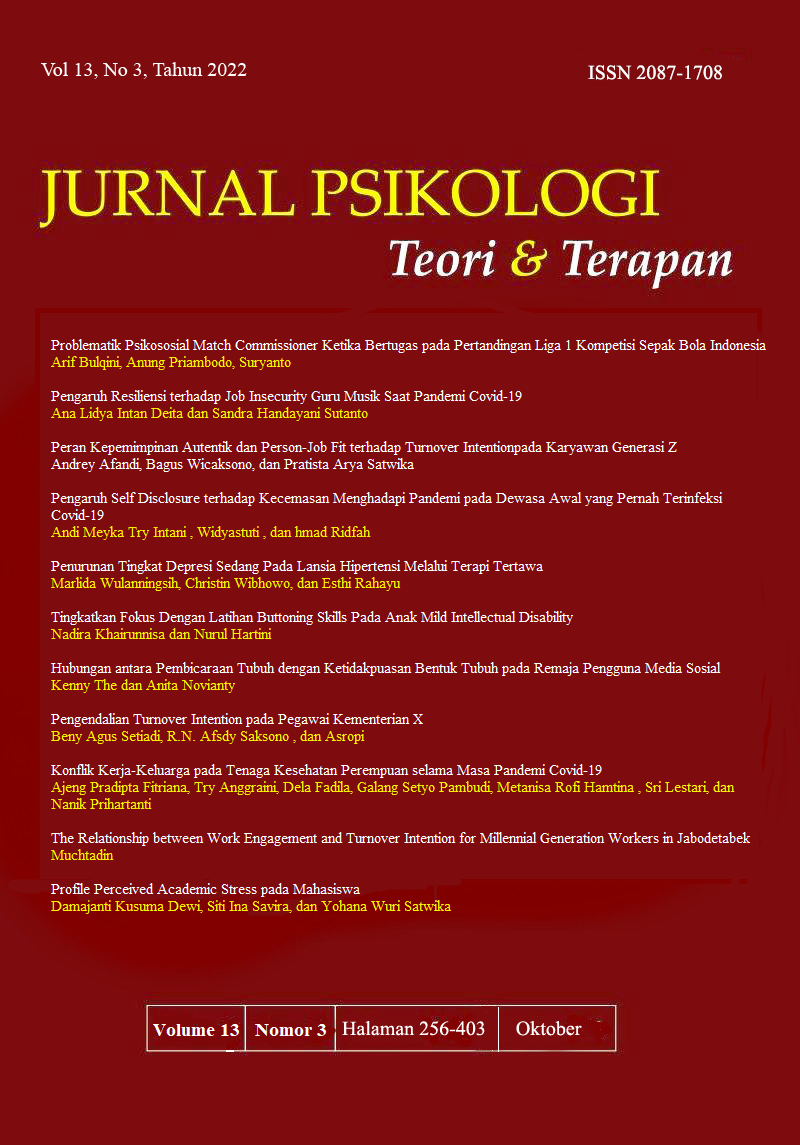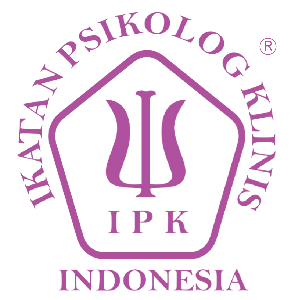Hubungan antara Pembicaraan Tubuh dengan Ketidakpuasan Bentuk Tubuh pada Remaja Pengguna Media Sosial
DOI:
https://doi.org/10.26740/jptt.v13n3.p331-350Keywords:
Adolescent, Body Dissatisfaction, Body Talk, Social MediaAbstract
The development of a positive or negative body image becomes very important, especially during adolescence. This study aims to determine the relationship between negative fat talk, negative muscle talk, and positive body talk with body dissatisfaction of adolescent social media users. Data was collected by online survey which included Body Shape Questionnaire-34 (BSQ-34) and Body Talk Scale (BTS). This research uses purposive sampling. Participants consisted of 221 women and 35 men who met the inclusion criteria. In accordance with the first hypothesis, the results of the analysis show that there is a significant positive relationship between negative fat talk in the below and above average groups with body dissatisfaction. In line with the second hypothesis, it was found there was a significant positive relationship between negative muscle talk with body dissatisfaction. However, the third hypothesis of this study was rejected because there was no significant relationship between positive body talk and body dissatisfaction. The results of this study have implications for those who want to promote a positive body image about the characteristics of the target that needs to be targeted and suggestions for intervention.
References
Ahuja, K. K., Khandelwal, A., & Banerjee,
of fat talk and social influences on
body dissatisfaction among Indian
women during the pandemic. SAGE
Journals: International Journal of
Social Psychiatry, 00(0), 1-10.
body image in young people. The
Philadelphia Inquirer.
https://www.inquirer.com/health/coro
navirus
/body-image-pandemic-quarantine-z
oom-weight-gain-loss-20201028.htm
l
Arroyo, A. (2015). Magazine exposure and
body dissatisfaction: The mediating
roles of thin ideal internalization and
fat talk. Communication Research
Reports, 32(3), 246-252.
Arroyo, A., & Brunner, S. R. (2016).
Negative body talk as an outcome of
networking sites: body surveillance
and social comparison as potential
moderators. Journal of Applied
Communication Research, 44(3),
-235.
Arroyo, A., & Harwood, J. (2012).
Exploring the causes and
consequences of engaging in fat talk.
Journal of Applied Communication
Research, 40(2), 1-21.
Arroyo, A., Segrin, C., & Harwood, J.
(2014). Appearance-related
communication mediates the link
between self-objectification and
health and well-being outcomes.
Human Communication Research,
(4), 463-482. doi:
1111/hcre.12036
Asamoah, M. K. (2014). Re-examination
of the limitations associated with
correlational research. Journal of
Educational Research and Reviews,
(4), 45-52.
Baruah, T. D. (2012). Effectiveness of
social media as a tool of
communication and its potential for
technology enabled connections: A
micro-level study. IJSRP, 2(5), 1-10.
Batubara, J. R. L. (2010). Adolescent
development (Perkembangan
Remaja). Sari Pediatri, 12(1), 21-29.
qualitative study of adolescent
image-sharing practices on social
media. International Journal of
Child-Computer Interaction, 20,
-71. doi:
1016/j.ijcci.2019.03.002
Boone, H. N., & Boone, D. A. (2012).
Analyzing Likert Data. Journal of
Extension, 50(2), 1-5.
Bozsik, F., Whisenhunt, B. L., Hudson, D.
L., Bennett, B., & Lundgren, J. D.
(2018). Thin is in? Think again: The
rising importance of muscularity in
the thin ideal female body. Sex Roles,
, 609-615. doi:
1007/s11199-017-0886-0
Burgett, G. (2021, September 15).
Facebook responds to WSJ report
stating it's aware of the harmful
influence Instagram has on teens.
Digital Photography Review.
https://www.dpreview.com/news/711
/facebook-responds-to-wsj-r
eport-on-instagram-teen-harm
Candra, I. A. (2020). Hubungan antara
ketidakpuasan bentuk tubuh dengan
objektifikasi diri pada remaja
laki-laki dan perempuan pengguna
Instagram. (Skripsi tidak
dipublikasikan). Fakultas Psikologi
Universitas Kristen Krida Wacana,
Jakarta.
Carrotte, E. R., Prichard, I., & Lim, M. S.
media: A content analysis of
gendered images. Journal of Medical
Internet Research, 19(3), e95.
Casey, B. J., Duhoux, S., & Cohen, M. M.
(2010). Adolescence: What do
transmission, transition, and
translation have to do with it?.
Neuron, 67(5), 749-760.
Cataldo, I., De Luca, I., Giorgetti, V.,
Cicconcelli, D., Bersani, F. S.,
Imperatori, C., Abdi, S., Negri, A.,
Esposito, G., & Corazza, O. (2021).
Fitspiration on social media:
Body-image and other
psychopathological risks among
young adults. A narrative review.
Emerging Trends in Drugs,
Addictions, and Health, 1, 1-6.
Chow, C. M., Hart, E., & Tan, C. C.
(2018). Interactive role of weight
status and fat talk on body
dissatisfaction: An observation of
women friends. Eating and Weight
Disorder - Studies on Anorexia,
Bulimia, and Obesity, 24, 1-10.
Cohen, R., Irwin, L., Newton-John, T., &
Slater, A. (2019). #bodypositivity: A
content analysis of body positive
accounts on Instagram. Body Image,
1016/j.bodyim.2019.02.007
Compeau, A., & Ambwani, S. (2013).
Effects of fat talk on body
dissatisfaction and eating behavior:
The moderating role of dietary
restraint. Body Image, 10(4),
-461.
Cooper, P. J., Taylor, M. J., Cooper, Z., &
Fairburn, C. G. (1987). The
development and validation of the
Body Shape Questionnaire.
International Journal of Eating
Disorders, 6(4), 485-494. doi:
1002/1098-108X(198707)6:4<48 5::AID
EAT2260060405>3.0.CO;2-O
Creswell, J. W. (2012). Educational
research: Planning, conducting, and
evaluating quantitative and
qualitative research (4th ed.). Upper
Saddle River, NJ: Merrill.
Creswell, J. W., & Creswell, J. D. (2018).
Research design: Qualitative,
quantitative, and mixed methods
approaches (5th ed.). Los Angeles:
SAGE.
Dewi, V. R., & Winduwati, S. (2019).
Kampanye tubuh positif perempuan
@Nipplets_officials. Prologia, 3(2),
-333.
Dzahabiyah, R. (2020). Pengaruh fat talk
terhadap body dissatisfaction pada
mahasiswa di kota Bandung. (Tesis
dipublikasikan). Fakultas Ilmu
Pendidikan UPI, Bandung.
Engeln, R., Sladek, M. R., & Waldron, H.
(2013). Body talk among college
men: Content, correlates, and effects.
Body Image, 10(3), 300-308.
Engeln-Maddox, R., Salk, R. H., & Miller,
negative commentary on their own
bodies. Psychology of Women
Quarterly, 36(2), 162-178.
Etikan, I., & Bala, K. (2017). Sampling
and sampling methods. Biometrics &
Biostatistics International Journal,
(6), 215-217. doi:
15406/bbij.2017.05.00149
Field, A. (2009). Discover statistics using
SPSS (3rd ed.). London: SAGE
Publications Ltd.
Field, A. E., Camargo Jr, C. A., Taylor, C.
B., Berkey, C. S., Roberts, S. B., &
Colditz, G. A. (2001). Peer, parent,
and media influences on the
development of weight concerns and
frequent dieting among
preadolescent and adolescent girls and boys. PEDIATRICS, 107(1),
-60. doi: 10.1542/peds.107.1.54
Fredrickson, B. L., & Roberts, T.-A.
(1997). Objectification Theory:
lived experiences and mental health
risks. Psychology of Women
Quarterly, 21(2), 173-206. doi:
1111/j.1471-6402.1997.tb00108.x
Grogan, S. (2017). Body image:
Understanding body dissatisfaction
in men, women and children. New
York: Routledge.
Hart, E., Chow, C. M., & Tan, C. C.
(2017). Body talk, weight status, and
pathological eating behavior in
romantic relationships. Appetite, 117,
Hartati, P., & Novianty, A. (2021).
Ketidakpuasan tubuh dan
internalisasi media pada remaja.
Jurnal Ilmiah Psikologi Terapan,
(1), 14-27.
Japil, A.R., Mustapha, M., & Eee, G.T.
(2017). Body dissatisfaction among
male and female adolescents. Jurnal
Psikologi dan Kesehatan Sosial
(JPsiKS), 1, 1-7.
Jones, D.C., & Crawford, J.K. (2006). The
peer appearance culture during
adolescence: Gender and body mass
variations. Journal of Youth
Adolescence, 35(2), 243-255.
Kaloeti, P. P., & Dewi, S. P. (2020).
Analisis faktor konfirmatori konsep
Water Sensitive City pada kawasan
pemukiman di kecamatan
Banyumanik. Jurnal Pemukiman,
(2), 84-94.
Kumar, M., & Dwivedi, S. (2020). Impact
of Coronavirus imposed lockdown
on Indian population and their habits.
International Journal of Science and
Healthcare Research, 5(2), 88-97.
Measuring positive and negative
body talk in men and women: The
development and validation of the
Body Talk Scale. Body Image, 37,
-116. doi:
1016/j.bodyim.2021.01.013
Lin, L., Flynn, M., & Roberge, A. (2019).
Hearing vs. engaging in negative
body talk: An examination of adult
men. Eating Disorders, 27(6),
-549.
Martz, D. M., Petroff, A. B., Curtin, L., &
Bazzini, D. G. (2009). Gender
differences in fat talk among
American adults: Results from the
Psychology of Size survey. Sex
Roles: A Journal of Research,
(1-2), 34-41. doi:
1007/2Fs11199-009-9587-7
Mills, J., & Fuller-Tyszkiewicz, M. (2016).
Fat Talk and Body Image
Disturbance. Psychology of Women
Quarterly, 41(1), 114-129. doi:
1177/0361684316675317
Obilor, E. I., & Amadi, E. C. (2018). Test
correlation coefficient (r).
International Journal of Innovative
Mathematics, Statistics & Energy
Policies, 6(1), 11-23.
Permatasari, B. (2012). Hubungan antara
penerimaan terhadap kondisi fisik
dengan kecenderungan anorexia
nervosa pada remaja perempuan di
SMAN 1 Banjarmasin. JURNAL
EDUKASI: Jurnal Bimbingan
Konseling, 5(2), 121-135.
Rudiger, J. A., & Winstead, B. A. (2013).
Body talk and body-related
co-rumination: Associations with
body image, eating attitudes, and
psychological adjustment. Body
Image, 10(4), 462-471. doi:
1016/j.bodyim.2013.07.010
Salk, R. H., & Engeln-Maddox, R. (2011).
1177/0361684310384
Sanemo, L. T., & Novianty, A. (2021).
Hubungan fat talk dengan perilaku
pengendalian berat badan tidak sehat
pada remaja perempuan. Dalam Sari,
M. P., Prosiding Konferensi Nasional
I Konsorsium Psikologi (KN1KP)
LLDIKTI 3 2021: Peran psikologi di
era pandemi dalam membangun
masyarakat berkarakter dan berdaya
saing global (pp. 426-437). Jakarta:
Penerbit Universitas Katolik
Indonesia Atma Jaya.
Schober, P., Boer, C., & Schwarte, L. A.
(2018). Correlation coefficients:
Appropriate use and interpretation.
Anesth Analg, 126(5), 1763-1768.
doi: 10.1213/ane.0000000000002864
Shahzad, S., Iftikhar, A., Sultana, H. F.,
Batool, H., Maryam, I., Asif, R., &
Azhar, S. (2018). Association of
eating disorder and body image
concern among female students
-21 year of age in Government
Home Economics College, Lahore,
Pakistan. International Archives of
BioMedical and Clinical Research,
(4), 22-25.
Sharpe, H., Naumann, U., Treasure, J., &
Schmidt, U. (2013). Is fat talking a
causal risk factor for body
dissatisfaction? A systematic review
and meta-analysis. International
Journal of Eating Disorder, 46 (7),
-652. doi: 10.1002/eat.22151
Sitepu, F. H., Effendy, E., & Amin, M. M.
(2020). Validity and reliability of
instruments Body Shape
Questionnaire-34 based on Indonesia
version. Egyptology, 17(6),
-1555.
Sladek, M. R., Engeln, R., & Miller, S. A.
(2014). Development and validation
of the Male Body Talk Scale: A
psychometric investigation. Body
Image, 11(3), 233-244.Sladek, M. R., Salk, R. H., & Engeln, R.
(2018). Negative body talk measures
for Asian, Latina(o), and White
women and men: Measurement
equivalence and associations with
ethnic-racial identity. Body Image,
, 66-77. doi:
1016/j.bodyim.2018.02.005
Supardi. (1993). Laporan Penelitian:
Populasi dan Sampel Penelitian.
UNISIA, 17, 100-108.
Talbot, C. V., Gavin, J., van Steen, T., &
Morey, Y. (2017). A content analysis
of thinspiration, fitspiration, and
bonespiration imagery on social
media. Journal of Eating Disorders,
(1). doi:
1186/s40337-017-0170-2
Thalia, P. (2020). Pengaruh pemaparan
gambar "fitspiration" dan kata
mutiara tentang "self-love" terhadap
ketidakpuasan tubuh. (Skripsi tidak
dipublikasikan). Fakultas Psikologi
Universitas Kristen Krida Wacana,
Jakarta.
Tiggemann, M., & Zaccardo, M. (2015).
effect of fitspiration imagery on
, 61-67.
Ursachi, G., Horodnic, I. A., Zait, A.
(2015). How reliable are
measurement scales? External
factors with indirect influence on
reliability estimators. Procedia
Economics and Finance, 20,
-686. doi:
1016/S2212-5671(15)00123-9
van Tour, M. (2018). Fat talk in online
discourse: A comparison of
pro-anorexia and body positivity on
social media. (Thesis published).
Wade, A. (2016). The impact of exposure
to fat talk and fat talk challenging
through social media on women.
(Disertasi Dipublikasikan). Department of Psychology and
University, Texas.
Wang, Y., Wang, X., Yang, J., Zeng, P., &
Lei, L. (2019). Body talk on social
networking sites, body surveillance,
and body shame among young
adults: The roles of self-compassion
and gender. Sex Roles, 82(6), 1-12.
doi: 10.1007/s11199-019-01084-2
Warren, C. S., Holland, S., Billings, H., &
Parker, A. (2012). The relationships
between fat talk, body
dissatisfaction, and drive for
thinness: Perceived stress as a
moderator. Body Image, 9(3),
-364. doi:
1016/j.bodyim.2012.03.008
Wells, G., Horwitz, J., & Seetharaman, D.
(2021, September 14). Facebook
knows Instagram is toxic for teen
girls, company documents show: Its
own in-depth research shows a
significant teen mental-health issue
that Facebook plays down in public.
The Wall Street Journal.
https://www.wsj.com/articles/facebo
ok-knows-instagram-is-toxic-for-tee
n-girls-company-documents-show-1
Widhiarso, W. (2010). Catatan pada uji
linearitas hubungan. Manuskrip
tidak dipublikasikan, Fakultas
Psikologi, Universitas Gadjah Mada,
Yogyakarta.
Wood-Barcalow, N. L., Tylka, T. L., &
Augustus-Horvath, C. L. (2010).
body image characteristics and a
holistic model for young-adult
women. Body Image, 7(2), 106-116.
doi: 10.1016/j.bodyim.2010.01.001
Yang, C. J., Gray, P., & Pope, H. G.
(2005). Male body image in Taiwan
versus the West: Yanggang Zhiqi
meets the Adonis complex. American Journal of Psychiatry,
(2), 263-269.
Downloads
Published
How to Cite
Issue
Section
License

This work is licensed under a Creative Commons Attribution-NonCommercial 4.0 International License.
Authors who publish in this journal agree to the following terms:
Copyright in any article is held by the author.
The author grants the journal, publication rights with the work simultaneously licensed under a Creative Commons Attribution License that allows others to share the work with an acknowledgment of the work's authorship and initial publication in this journal.
Authors may enter into separate, additional contractual arrangements for the non-exclusive distribution of the journal's published version of the work (e.g., posting it to an institutional repository or publishing it in a book), with an acknowledgment of its initial publication in this journal.
Authors are permitted and encouraged to post their work online (e.g., in an institutional repository or on their website) prior to and during the submission process, as this can lead to productive exchanges, as well as earlier and greater citation of published work.
 Abstract views: 1555
,
Abstract views: 1555
, PDF Downloads: 1477
PDF Downloads: 1477


















